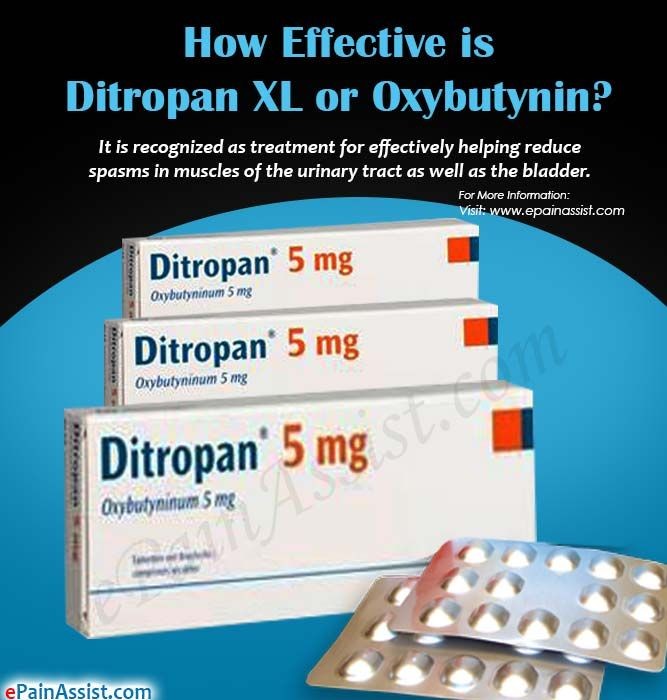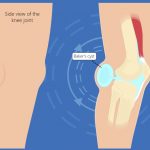
Contents
Side Effects of Ditropan XL (oxybutynin)
Ditropan XL is an antispasmodic and anticholinergic drug that treats urinary bladder spasm.
Ditropan XL has a dual mechanism of action. The release of acetylcholine by the nerves within the bladder stimulates the contraction of the bladder’s smooth muscle. By blocking the release of acetylcholine, Ditropan XL suppresses involuntary contractions (spasms) of the bladder’s smooth muscle. Additionally, it directly relaxes the bladder’s outer layer of muscle (the detrusor muscle).
Common side effects of Ditropan XL include:
- dry mouth
- constipation
- tiredness
- headache
- diarrhea
- urinary tract infection (UTIs)
- blurred vision, difficulty urinating, and local reactions at the application site (itching and rash with transdermal patch use)
Serious side effects of Ditropan XL can include hypersensitivity reactions involving swelling of the throat, lips, and tongue.
Ditropan XL may interact with other anticholinergic drugs or agents that produce dry mouth, constipation, and drowsiness. This can increase the frequency and/or severity of these effects.
It is important to consult your doctor before breastfeeding while taking Ditropan XL, as its excretion in human milk is unknown.
Important Side Effects of Ditropan XL (oxybutynin)
The most common side effects of oxybutynin include:
Approximately 1 in every 14 patients taking oxybutynin tablets cannot tolerate it due to side effects. Other possible side effects include diarrhea, urinary tract infections, blurred vision, and difficulty urinating.
The transdermal patch or gel may also cause itching and rash at the application sites, but generally has fewer side effects than the tablets. Serious hypersensitivity reactions involving swelling of the throat, lips, and tongue can also occur.
Ditropan XL (oxybutynin) Side Effects for Healthcare Professionals
The safety and efficacy of Ditropan (oxybutynin chloride) was evaluated in three clinical trials with a total of 199 patients. These participants were treated with Ditropan 5-20 mg/day for up to 6 weeks.
The most common adverse events reported by patients receiving Ditropan 5-20 mg/day were the expected side effects of anticholinergic agents. Dry mouth occurred with a higher incidence in a dose-related manner.
| Body System | Adverse Event | Ditropan (5-20 mg/day) (n=199) |
| Infections and Infestations | Urinary tract infection | 6.50% |
| Psychiatric Disorders | Insomnia | 5.50% |
| Nervousness | 6.50% | |
| Nervous System Disorders | Dizziness | 16.60% |
| Somnolence | 14.00% | |
| Headache | 7.50% | |
| Eye Disorders | Blurred vision | 9.60% |
| Gastrointestinal Disorders | Dry mouth | 71.40% |
| Constipation | 15.10% | |
| Nausea | 11.60% | |
| Dyspepsia | 6.00% | |
| Renal and Urinary Disorders | Urinary Hesitation | 8.50% |
| Urinary Retention | 6.00% |
In addition, the following adverse events were reported by 1 to < 5% of patients using Ditropan (5-20 mg/day) in all studies:
Infections and Infestations: nasopharyngitis, upper respiratory tract infection, bronchitis, cystitis, fungal infection;
Metabolism and Nutrition Disorders: fluid retention;
Psychiatric Disorders: confusional state;
Nervous System Disorders: dysgeusia, sinus headache;
Eye Disorders: keratoconjunctivitis sicca, eye irritation;
Vascular Disorders: flushing;
Respiratory, Thoracic and Mediastinal Disorders: nasal dryness, cough, pharyngolaryngeal pain, dry throat, sinus congestion, hoarseness, asthma, nasal congestion;
Gastrointestinal Disorders: diarrhea, abdominal pain, loose stools, flatulence, vomiting, upper abdominal pain, dysphagia, aptyalism, eructation, coated tongue;
Skin and Subcutaneous Tissue Disorders: dry skin, pruritis;
Musculoskeletal and Connective Tissue Disorders: back pain, arthralgia, extremity pain, flank pain;
Renal and Urinary Disorders: dysuria, pollakiuria;
General Disorders and Administration Site Conditions: fatigue, peripheral edema, asthenia, pain, thirst, edema;
Investigations: increased blood pressure, increased blood glucose, decreased blood pressure;
Injury, Poisoning, and Procedural Complications: fall.
Postmarketing Surveillance
Postmarketing adverse events are reported voluntarily and are difficult to reliably estimate their frequency or establish a causal relationship to drug exposure. The following additional adverse events have been reported from worldwide postmarketing experience with Ditropan:
Psychiatric Disorders: psychotic disorder, agitation, hallucination, memory impairment;
Nervous System Disorders: convulsions;
Eye Disorders: cycloplegia, mydriasis, glaucoma;
Cardiac Disorders: tachycardia, QT interval prolongation;
Gastrointestinal Disorders: decreased gastrointestinal motility;
Skin and Subcutaneous Tissue Disorders: rash, decreased sweating;
Renal and Urinary Disorders: impotence;
Reproductive System and Breast Disorders: suppression of lactation;
General Disorders and Administration Site Conditions: hypersensitivity reactions, including angioedema with airway obstruction, urticaria, and face edema; rare anaphylactic reactions requiring hospitalization for emergency treatment.
Drug Interactions
The concomitant use of oxybutynin with other anticholinergic drugs or drugs that produce dry mouth, constipation, and drowsiness may increase the frequency and severity of these effects.
Anticholinergic agents may potentially affect the absorption of concomitantly administered drugs due to their effects on gastrointestinal motility. This is particularly important for drugs with a narrow therapeutic index.
Oxybutynin mean plasma concentrations are higher when administered with ketoconazole, a potent CYP3A4 inhibitor.
Other inhibitors of the cytochrome P450 3A4 enzyme system, such as antimycotic agents (e.g., itraconazole and miconazole) or macrolide antibiotics (e.g., erythromycin and clarithromycin), may alter oxybutynin pharmacokinetic parameters. The clinical relevance of these interactions is not known. Caution should be exercised when co-administering such drugs.
Summary
Ditropan XL is an antispasmodic and anticholinergic drug used to treat urinary bladder spasm. Common side effects include dry mouth, constipation, tiredness, headache, diarrhea, urinary tract infection (UTIs), blurred vision, difficulty urinating, and local reactions at the application site. It is important to consult a doctor before breastfeeding while taking Ditropan XL.
Ditropan XL is an antispasmodic and anticholinergic drug used to treat urinary bladder spasm. Common side effects include dry mouth, constipation, tiredness, headache, diarrhea, urinary tract infection (UTIs), blurred vision, difficulty urinating, and local reactions at the application site. It is important to consult a doctor before breastfeeding while taking Ditropan XL.


